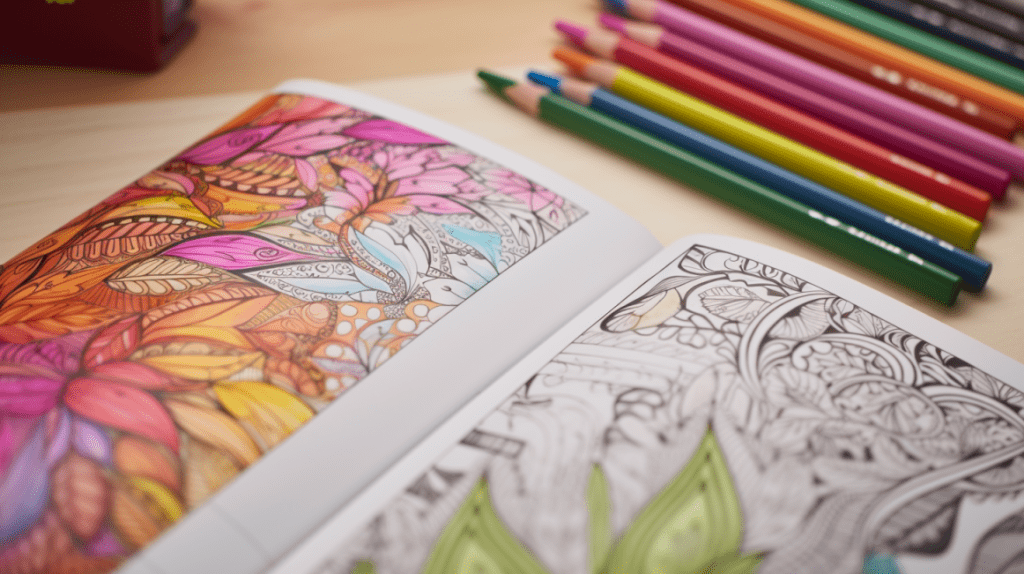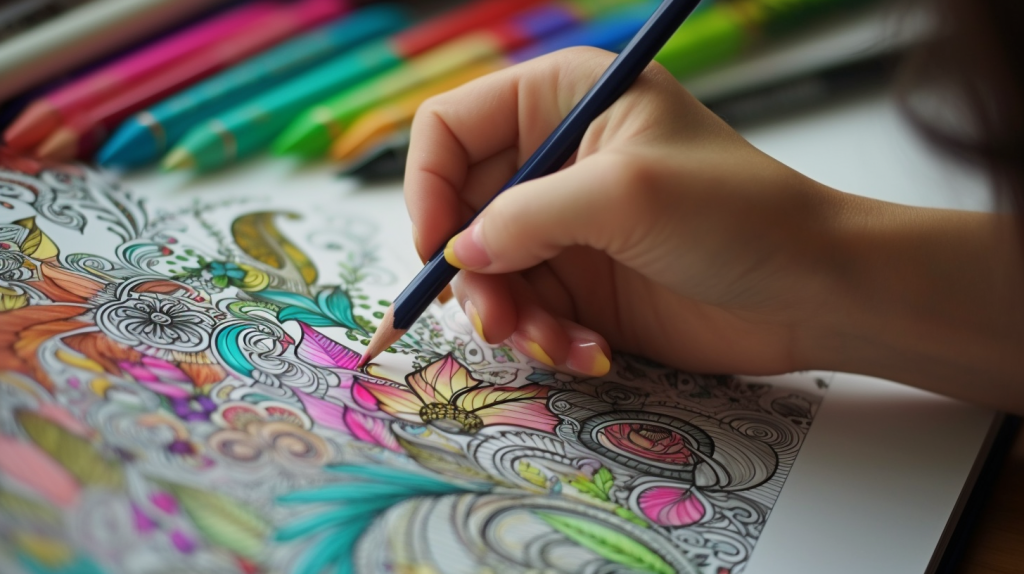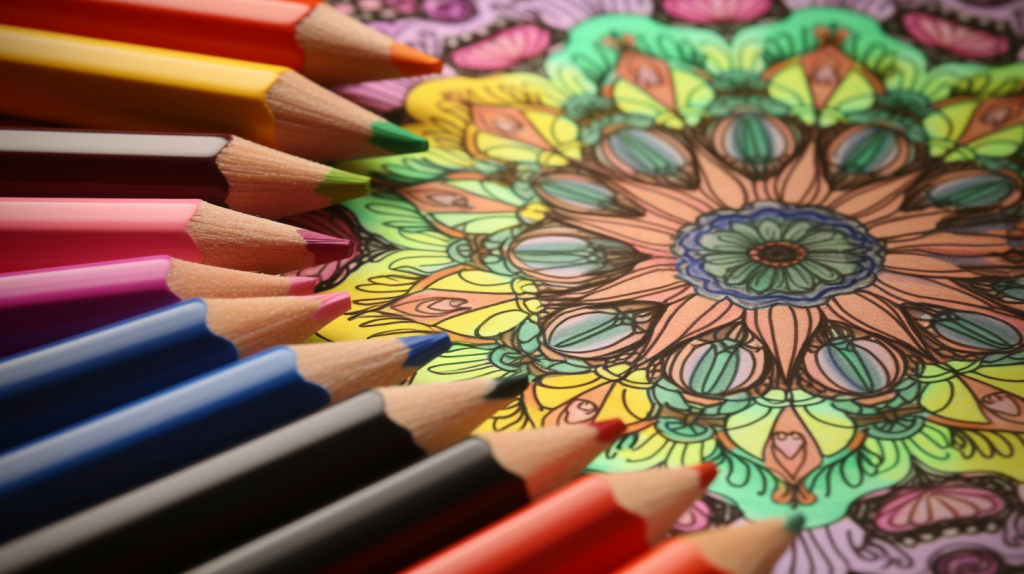Coloring can be a powerful practice for relaxation and mindfulness. By incorporating meditation techniques into the coloring process, individuals can tap into the soothing power of mindfulness and transform their art into a peaceful retreat. This article explores the benefits of coloring as a mindfulness practice, provides tips for incorporating meditation techniques into coloring, and introduces various meditation techniques that can be explored while coloring. Whether you are seeking stress relief, relaxation, or a way to enhance your creativity, coloring can be a meditative activity that brings peace and tranquility to your life.

Key Takeaways:
- Mindfulness coloring combines the calming benefits of meditation with the therapeutic act of coloring.
- Coloring as a mindfulness practice can reduce anxiety, lower symptoms of depression, and improve mood.
- Incorporating meditation techniques into coloring involves approaching the activity with curiosity and joy, grounding oneself through the senses, and letting go of perfectionism.
- Various meditation techniques can be used while coloring, such as color therapy, storytelling, affirmations, visual meditation, breathing meditation, and manifestation meditation.
- Color meditation involves paying attention to the colors in one’s visual field and cultivating awareness and presence in the moment.
The Benefits of Coloring as a Mindfulness Practice
Coloring is not just a fun activity for children; it can also be a powerful tool for mindfulness and self-care. When practiced with intention and focus, coloring can provide numerous benefits for our mental and emotional well-being.
One of the key advantages of coloring as a mindfulness practice is its ability to help us be fully present in the moment. As we engage with the colors and shapes on the page, our attention naturally focuses on the task at hand. This allows us to momentarily let go of worries, anxieties, and external distractions, creating a space for inner calm and tranquility.
Coloring can also induce a state of relaxation, reducing stress and anxiety. As we pick up our pens or pencils and start to color, our brains shift from the busy beta brainwave state to a more relaxed alpha or theta state. This shift in brain activity promotes a sense of calmness and can help us unwind from the pressures of daily life.
Moreover, coloring provides us with a means of self-expression and creativity. It allows us to choose colors that resonate with our emotions, mood, and inner world. Whether we opt for vibrant hues or soothing pastels, the act of coloring becomes a language through which we can communicate and explore our innermost thoughts and feelings.
By engaging in coloring as a meditative activity, we can experience a sense of calmness and inner peace. The repetitive and rhythmic motions of coloring can induce a state of flow, where we become fully absorbed in the present moment. This flow state can be deeply satisfying and fulfilling, enhancing our overall well-being.
Incorporating coloring as a mindfulness practice into our daily routine can be a simple yet transformative way to nurture ourselves. It offers a respite from the busyness and demands of life, allowing us to slow down, reconnect with ourselves, and find solace in the colors and lines that grace the pages of our coloring books.
Coloring can be a gateway to the world of mindfulness and self-discovery. It provides a safe and gentle space for us to explore our inner landscapes, cultivate awareness, and find serenity in the act of creation. Whether it’s through mindful coloring techniques or simple moments of coloring for relaxation, incorporating coloring into our lives can have profound effects on our mental, emotional, and spiritual well-being.
Tips for Incorporating Meditation Techniques into Coloring
When it comes to incorporating meditation techniques into coloring, there are several valuable strategies to enhance your mindful experience. By implementing these tips, you can make your coloring sessions more relaxing, therapeutic, and fulfilling:
- Let your inner child play: Approach coloring with a sense of curiosity and joy. Allow yourself to explore different color combinations and experiment with various materials. Embrace the freedom of self-expression and creativity in your coloring process.
- Focus your attention: Bring your attention fully to the coloring page. Ground yourself in the present moment by engaging your senses. Notice the sensations of the pencil or marker in your hand, the texture of the paper, and the sound of coloring strokes. By immersing yourself in the activity, you can deepen your mindful experience.
- Let go of perfectionism: Release any pressure to create a perfect masterpiece. Coloring is about the process, not just the end result. Allow yourself to enjoy the journey and the act of coloring without worrying about the outcome. Embrace the imperfections and let your coloring be a reflection of your unique expression.
- Use inspiring and sustainable tools: Choose coloring materials that resonate with your values. Opt for recycled coloring books and eco-friendly art supplies to create a mindful coloring practice that aligns with your commitment to the environment. By using sustainable tools, you can further enhance the connection between your coloring and the world around you.
By implementing these tips, you can transform your coloring sessions into a powerful practice of mindfulness and self-discovery. Let your creativity flow as you engage in mindful coloring, and embrace the therapeutic benefits it brings.

Immerse yourself in the world of coloring as a meditative activity and discover the transformative power it holds for relaxation, self-expression, and mindfulness.
Exploring Different Meditation Techniques While Coloring
When it comes to mindfulness coloring, there are various meditation techniques that can take your coloring experience to a whole new level. By incorporating these techniques, you can enhance your relaxation, focus, and creativity. Let’s explore some of these techniques:
Color Therapy
In color therapy, individuals choose color schemes that evoke specific feelings or moods. By selecting colors that resonate with their emotions, they can create a harmonious and calming atmosphere during the coloring process.
Storytelling
Storytelling is a delightful technique that allows individuals to create uplifting narratives about the characters they are coloring. This technique sparks imagination and unleashes creativity, giving life to their artwork and making the coloring experience even more enjoyable.
Affirmations
Writing affirmations on coloring pages is another powerful technique. By using positive statements related to self-love, gratitude, or personal growth, individuals can infuse their coloring practice with a sense of empowerment and positivity.
Visual Meditation and Breathing Meditation
After completing a coloring session, individuals can engage in visual meditation or breathing meditation. Visual meditation involves reflecting on the completed artwork, observing the colors, shapes, and details with a sense of mindfulness. Breathing meditation, on the other hand, focuses on deep, intentional breaths, allowing individuals to cultivate inner peace and relaxation.
Manifestation Meditation
Manifestation meditation can be practiced by coloring pictures that represent desired outcomes or goals. By infusing the coloring process with intention and visualization, individuals bring their aspirations to life and strengthen their manifesting energy.
Simple Coloring as Meditation
Finally, sometimes the simplicity of coloring without any specific technique can be a meditative practice in itself. By slowing down their minds and finding peace in the act of coloring, individuals can experience a sense of calm and tranquility.

These meditation techniques offer a range of possibilities to deepen your mindfulness coloring practice. Whether you choose to explore color therapy, storytelling, affirmations, or simply let your creativity flow, incorporating these techniques can transform your coloring experience into a calming, meditative retreat.
Exploring Colors in Meditation
Meditation can take many forms, and one captivating technique involves exploring colors. Color meditation invites individuals to pay attention to the colors present in their visual field and cultivate awareness of them. This practice can enhance a sense of awe, wonder, and clarity, bringing a deeper level of presence and mindfulness to one’s journey. Whether you find yourself outdoors surrounded by nature’s vibrant hues or in the comfort of your home, color meditation can be practiced anywhere with remarkable ease.
“Color is a power which directly influences the soul.” – Wassily Kandinsky
During color meditation, choose one color to focus on at a time. Engage your senses and observe the objects of that particular color with a beginner’s mind. Take some time to absorb the nuances and subtleties of the color’s hue, saturation, and brightness. Allow yourself to fully experience the color and its impact on your visual perception. As you dive deeper into this practice, you’ll discover the profound effects of color on your thoughts, emotions, and overall well-being.
Color meditation can be complemented by incorporating a color meditation script, which guides your focus and deepens your connection with the chosen color. Here’s an example of a simple color meditation script:
Color Meditation Script
Find a comfortable position and take a few deep breaths to center yourself.
Close your eyes and imagine a serene space filled with the color of your choice.
Begin to visualize this color enveloping the entire space, creating a soothing and peaceful atmosphere.
As you breathe in, imagine yourself inhaling the essence of this color and feel it filling your entire being.
With each breath, sense the color infusing you with serenity, tranquility, and mindfulness.
Allow yourself to become fully immersed in the experience, embracing the sensations and feelings that arise.
When you’re ready, gently open your eyes and carry the energy of the color with you throughout your day.
Engaging in color meditation can be a profound and transformative experience, helping you to deepen your mindfulness practice and broaden your connection with the world around you. Through the exploration of colors, you can tap into a wellspring of inspiration, self-reflection, and inner peace.

The Role of Coloring in Increasing Sight Awareness
Engaging in coloring exercises that focus on colors can help increase sight awareness. By actively observing and paying attention to colors, individuals can strengthen their visual perception and become more attuned to the world around them. This can lead to a greater appreciation for the beauty and intricacies of different colors and enhance the practice of mindfulness overall.
Coloring provides a unique opportunity to immerse oneself in the visual realm and develop a heightened sense of sight awareness. When we color, we engage our eyes and minds in a conscious exploration of different hues, shades, and tones. By focusing on the colors we choose and the strokes we make, we train our eyes to perceive subtle variations and details that may have gone unnoticed before.
This increased sight awareness can extend beyond the coloring page and into our daily lives. As we become more attuned to colors, we start to appreciate the vibrant hues of nature, the artistry in everyday objects, and the interplay of different shades in our surroundings. This newfound awareness brings a sense of awe and wonder, allowing us to see the world with fresh eyes.
Incorporating sight awareness into mindfulness coloring also deepens the connection between the mind and the body. As we focus on the act of coloring and observe the colors unfolding on the page, we cultivate a sense of presence and embodiment. This integration of visual perception and physical engagement creates a holistic experience that nurtures both the mind and the senses.
“Coloring is a gateway to unlocking the beauty of the world around us. It invites us to see with intention, appreciate the splendor of colors, and cultivate a mindful connection to our visual surroundings.”
A mindfulness practitioner
Enhancing Sight Awareness through Color Meditation
Color meditation is a powerful complement to mindfulness coloring as it further enhances sight awareness. By incorporating color meditation into our practice, we can deepen our connection to color and foster a more profound understanding of its impact on our well-being.
One simple color meditation script involves focusing on a specific color and immersing ourselves in its presence. We can choose a color that resonates with us or simply let the color choose us. Here is a brief color meditation script to guide you:
Find a comfortable position and take a few deep breaths to center yourself. Close your eyes and bring your attention to your breath. Allow your breath to become calm and steady.
When you’re ready, imagine a color that evokes a sense of calm or joy within you. Picture this color in your mind’s eye, visualizing its vibrancy and energy.
As you continue to breathe deeply, imagine this color surrounding you, enveloping your body and filling your surroundings. Feel its essence and energy washing over you.
Now, open your eyes and observe the colors around you. Notice how the color you chose resonates and interacts with the colors in your environment. Pay attention to the subtle variations and contrasts.
Take a few moments to fully immerse yourself in the experience of color. Notice how it influences your mood, emotions, and overall sense of awareness. Embrace the beauty and presence of color in this moment.
When you’re ready, take a deep breath and gradually shift your focus back to your breath, bringing your color meditation to a gentle close.
This color meditation script can be practiced for a few minutes each day and can serve as a valuable tool for strengthening your sight awareness and deepening your mindfulness practice. Embrace the transformative power of color and let it guide you on a journey of heightened perception and inner presence.
Practicing Color Meditation
Color meditation is a wonderful way to deepen your mindfulness practice. By dedicating a specific time to focus on colors, you can explore them with curiosity and openness. Here’s a simple color meditation script you can try:
- Prepare: Find a quiet and comfortable space where you can relax and concentrate. Take a few deep breaths to center yourself.
- Select a color: Choose a color that resonates with you or that you feel drawn to today. It can be any color of your choice.
- Observe: Focus your attention on the selected color. Notice its hue, intensity, and any variations or shades of that color.
- Look around: Look around your environment and observe any objects or surroundings that match the selected color. Take your time to truly see and appreciate them.
- Engage your senses: Engage your senses fully as you observe the color. Notice the textures, patterns, and shapes associated with the objects of that color.
- Cultivate presence: Stay present with the color and the objects for approximately 10 minutes. Allow yourself to experience a sense of awe, wonder, and clarity.
- Reflect: After the meditation, take a moment to reflect on your experience. Notice any shifts in your state of mind and any insights or emotions that arose during the practice.
Remember, there’s no right or wrong way to practice color meditation. It’s all about cultivating awareness and presence through the exploration of colors. You can incorporate this practice into your daily life to enhance your mindfulness journey. Take a moment to try this simple meditation and embrace the beauty and power of colors.
| Benefits of Color Meditation | Tips for Successful Color Meditation |
|---|---|
|
|
Improving Mindfulness with Color Meditation
Color meditation is a powerful practice that can enhance mindfulness and deepen your connection to the present moment. By bringing awareness to the colors in your environment and practicing focused observation, you can cultivate a greater sense of mindfulness in your daily life.
“Color is a power that directly influences the soul.” – Wassily Kandinsky
Mindfulness exercises through coloring provide an opportunity to engage all of your senses and immerse yourself in the present moment. As you focus on the colors and strokes of your artwork, you can let go of distractions and enter a state of flow.
Whether you’re using a color meditation script or simply allowing your intuition to guide you, coloring can be a transformative journey of self-exploration and self-expression. It’s a chance to quiet your mind, reduce stress and anxiety, and tap into your creative potential.
Benefits of Color Meditation:
- Promotes relaxation and reduces stress
- Enhances focus and clarity
- Encourages self-expression and creativity
- Provides a meditative and calming experience
| Color Meditation Techniques | Description |
|---|---|
| Color Visualization | Imagine yourself surrounded by a specific color and immerse yourself in its energy. |
| The Color Breathing Technique | Breathe in deeply while visualizing a specific color. Imagine the color filling your lungs and releasing any tension or stress as you exhale. |
| Gradient Coloring | Start coloring with one color and gradually transition to different shades. Observe the subtle changes and transitions as you color. |
| Color Reflection | Choose a completed coloring page and observe the colors and shapes. Reflect on the emotions and thoughts evoked by the artwork. |
Remember, there is no right or wrong way to practice color meditation. It’s about finding what resonates with you and allowing yourself to fully immerse in the experience. Embrace the power of color and let it guide you on your mindfulness journey.
Discover the transformative power of color meditation and unlock a deeper sense of mindfulness in your life. Start incorporating mindfulness exercises through coloring today!
Conclusion
Coloring can be a powerful practice for incorporating mindfulness into daily life. By using meditation techniques while coloring, individuals can tap into the soothing power of mindfulness and enhance relaxation, focus, and creativity. Whether through structured coloring exercises or simple free-form coloring, the act of coloring can provide a peaceful retreat and an opportunity for self-expression.
Through the world of coloring, individuals can explore their inner artist and unlock the transformative power it can have on their well-being. The combination of colors, patterns, and lines creates a meditative space where the mind can quiet down and find peace. By immersing oneself in the colors and engaging in the process, the worries and stresses of the day can melt away, and a sense of calm can be achieved.
So, why not give coloring a try? Grab your coloring supplies, find a comfortable spot, and embark on a journey of self-discovery and mindfulness. Allow your creativity to flow freely on the pages, creating beautiful and meaningful works of art. Experience the transformative power of coloring and unlock the many benefits it can bring to your well-being.






